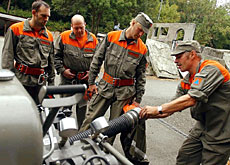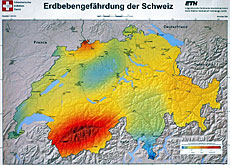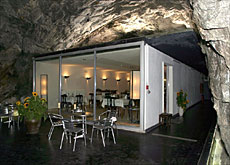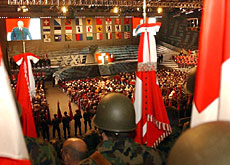Civil protection celebrates half century

The Swiss defence minister, Samuel Schmid, has praised Switzerland’s civil protection which now concentrates on emergency situations.
About 95 per cent of the population could now find room in an anti-nuclear shelter and in case of emergency quickly find shelter there.
Schmid was speaking in Bern at celebrations to mark the 50th anniversary of the Swiss Union for Civil Protection, which was set up during the Cold War.
But half a century after its foundation, the Union does not view the risk of an atomic war with as much apprehension as 50 years ago.
Schmid noted that Switzerland’s civil protection offered the possibility of long survival in times of catastrophe or emergency.
And he added that the organisation had been a “tower of strength” in the country’s civil protection system.
The Union has helped in setting up no fewer than 270,000 shelters in Switzerland.
For decades, billions of Swiss francs were invested in bunkers with the aim of providing shelter for every Swiss.
The government subsidised their construction and that of related infrastructure for years but no longer.
Speculation
“It would be pure speculation to try to put a figure in it,” commented Moritz Boschung, who is head of information at the Federal Office for Civil Protection.
However, a Union communiqué from the year 1984 mentions that half a billion Swiss francs ($430,800) was being spent annually on the shelters.
Only a handful of other countries, including Finland and Sweden have built up such a system.
The number of Swiss bunkers continues to increase. In regions where construction is intensive, all the population can already be sheltered. In areas where there is a shortage of places, new buildings must plan to include bunkers.
Switzerland also has 3,500 protected buildings which would act as command posts, first aid shelters and hospitals in a time of crisis.
A shelter has to be a least eight square metres in size, so as to provide space for five or six beds.
Shelter thousands
But some buildings can shelter thousands, for example the Beaulieu Exhibitions and Congress Centre in Lausanne, which has room for 3,000 people in the underground car park.
Boschung said that nowadays, the trend was to build bunkers to shelter 50 to 200 people because they were easier to manage.
It is all a far cry from the Cold War period when Switzerland was haunted by concerns of a nuclear attack.
In 1969, the government even issued a brochure called “Civil Defence” that was distributed to every Swiss household.
Written by Colonel Albert Bachmann, it contained more than explanations on how a shelter would function in time of war. It also gave advice on how to react and offer resistance in case of occupation of Switzerland by a foreign power.
But today, civil protection is mainly active in natural catastrophes or terrorist threats and armed conflict has taken a back seat.
Since 1990, the number of people who could be mobilised has fallen from 520,000 to 120,000.
swissinfo with agencies
The Swiss Union for Civil Protection was founded on November 21, 1954.
Billions of Swiss francs have been spent on shelters, for example SFr500 million in 1984 alone.
People available:
1989: 520,000
2004: 120,000
Number of shelters: 270,000

In compliance with the JTI standards
More: SWI swissinfo.ch certified by the Journalism Trust Initiative




You can find an overview of ongoing debates with our journalists here . Please join us!
If you want to start a conversation about a topic raised in this article or want to report factual errors, email us at english@swissinfo.ch.